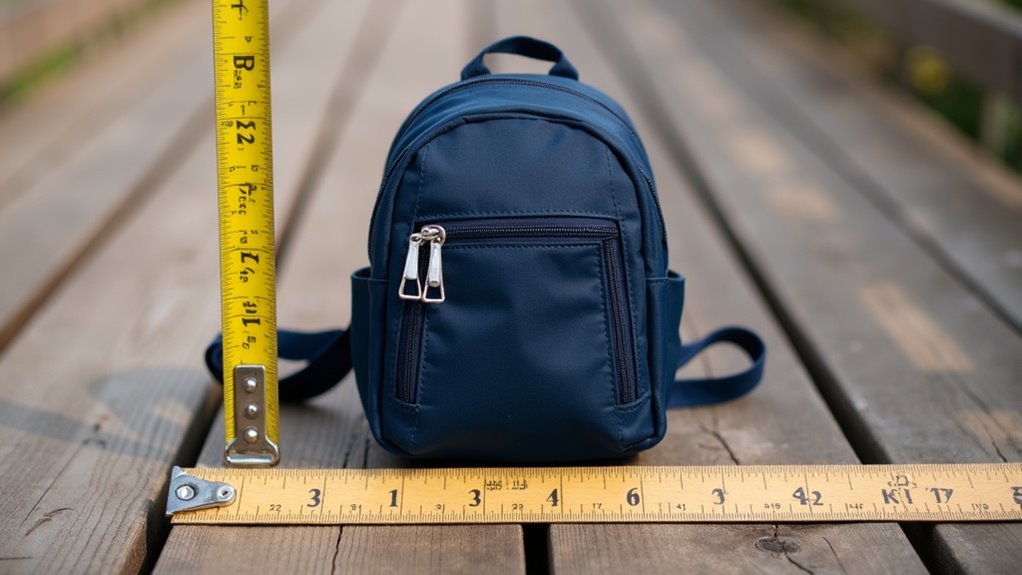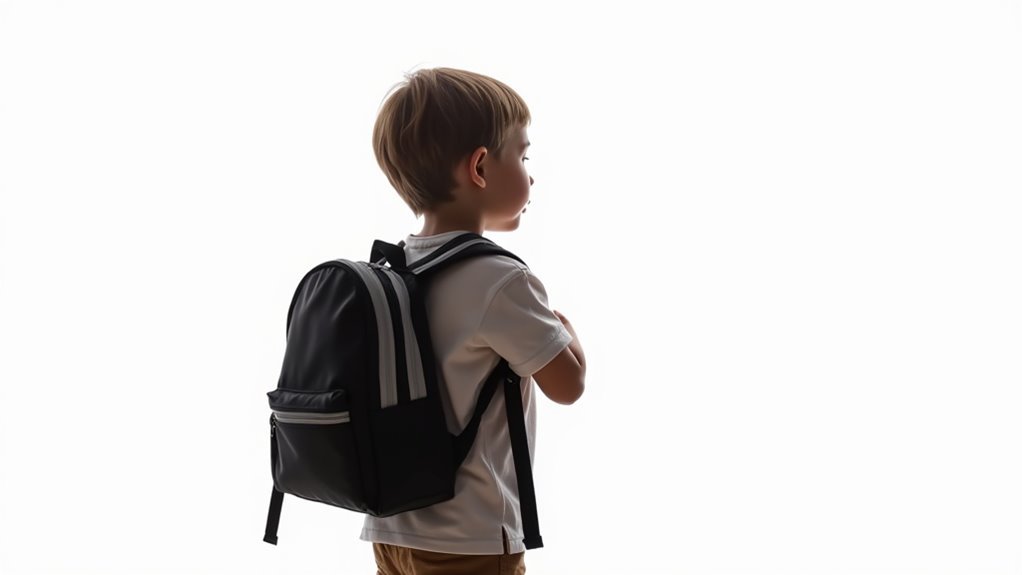When I’m helping parents choose kindergarten backpacks, I always start with the 15% rule – your child’s packed backpack shouldn’t exceed 15% of their body weight. For most kindergarteners, that means looking for backpacks between 20-28 liters with dimensions around 12 inches long and 7 inches wide. I’ve seen too many kids struggling with oversized bags that throw off their posture. The key is actually measuring your child’s torso and considering what they’ll carry daily. Below, I’ll walk you through the exact steps to guarantee perfect fit.
Why Backpack Size Matters for Young Students

When I think about sending my child off to kindergarten, choosing the right backpack size might seem like a small detail, but it’s actually one of the most important decisions I’ll make for their daily comfort and health. An improperly sized backpack is like forcing my child to carry a burden that’s too heavy or awkward for their small frame. I’ve learned that backpacks exceeding 15% of their body weight can cause serious back and shoulder problems. Well, I want my kindergartener to feel free and confident, not weighed down by unnecessary discomfort. Proper backpack weight distribution is essential to ensure that their spine remains healthy and supported throughout the school day.
Recommended Capacity Guidelines for Kindergarteners
Between 20 to 28 liters—that’s the sweet spot I’ve discovered for kindergarten backpack capacity, and honestly, it took me a while to figure out why this range matters so much. You see, this capacity perfectly accommodates folders, snacks, lunch, and school supplies without creating a burden. Here’s what really matters though: your child’s packed backpack shouldn’t exceed 15% of their body weight. I can’t stress this enough—it’s literally a safety issue. Think of it like this: would you want to carry a bowling ball on your back all day? Neither does your kindergartener.
Standard Dimensions and Measurements

Two key measurements—12 inches in length by 7 inches in width—represent the standard kindergarten backpack dimensions, but here’s what I’ve learned: there’s really no such thing as one-size-fits-all when it comes to kids.
Every child’s different, and you’ll want to take into account these factors:
- Your child’s height and shoulder width
- The size of their school supplies and folders
- Whether they’ll carry a lunch box daily
- Their comfort level with the backpack’s weight
I think it’s better to focus on proper fit rather than sticking rigidly to standard measurements—your child’s comfort matters more.
How to Measure Your Child for the Right Fit
Getting the right measurements for your child’s backpack isn’t rocket science, but it does require a measuring tape and about five minutes of your time. Start by measuring from their shoulders down to their belly button, then add two inches—that’s your height benchmark. Next, measure across their shoulder blades and add another two inches for width.
Here’s the thing: most kindergarten folders need at least 14 inches of height, so keep that in mind. I always tell parents to reflect on what their kid’s actually carrying. You don’t want them wrestling with an oversized pack every morning.
Weight Limits and Safety Considerations

While getting the size right matters, the weight your kindergarten student carries is actually the bigger safety concern. I can’t stress this enough – that little backpack can become a real burden if we’re not careful.
Here’s what I always tell parents about keeping things safe:
- Keep total weight under 15% of your child’s body weight
- A 40-pound kindergartener shouldn’t carry more than 6 pounds
- Heavier loads can mess with their posture and cause back pain
- Think of it like this – you wouldn’t want to lug around a bowling ball all day
Trust me, their growing bodies will thank you later.
Top Backpack Recommendations for Girls
Now that we’ve got the safety stuff sorted out, let’s talk about some fantastic backpack options for your little girl. I’m really impressed with the Jansport Digital Student Laptop Backpack – it’s spacious and has great padding for comfort. The Tilami Kids Rolling Backpack is another winner with 35L storage that converts to wheeled when she’s tired. Well, you know how kindergarteners can get worn out! Both options give your daughter the freedom to carry her essentials comfortably. I think these designs strike the perfect balance between style and functionality for active kids. Additionally, look for backpacks with smart internal organization features to help keep her belongings in place.
Best Backpack Options for Boys

When it comes to finding the perfect backpack for your little guy, I’ve got some solid recommendations that’ll handle whatever kindergarten throws at him.
Here are my top picks that actually work:
- Nike Kids’ Youth Elemental Backpack – 20L capacity that’s built like a tank for active boys
- Adidas Youth Classic 3S Backpack – Perfect 11.5 x 6 x 17 inch dimensions fit most kindergarteners
- Under Armour Storm Scrimmage Backpack – Weather-resistant because, well, kids happen
- Puma Big Kids’ Backpack – Lightweight yet durable for growing shoulders
These aren’t just tough-looking – they’re actually engineered for comfort and durability. When selecting a backpack, it’s essential to consider size, durability, and functionality to ensure it meets your child’s needs throughout the school year.
Ensuring Comfort and Proper Support
Since your child will be wearing their backpack for hours every day, getting the fit right isn’t just about comfort – it’s actually about preventing real injury. I think properly fitted straps are like having the right shoes – they make all the difference in how your kid feels at the end of the day.
Here’s what I look for when checking backpack fit:
| Feature | Proper Fit |
|---|---|
| Shoulder straps | Rest snugly on shoulders |
| Back panel | Sits flat against child’s back |
| Hip belt | Optional but helpful for distribution |
| Chest strap | Prevents straps from sliding |
| Overall position | Bottom sits at waist level |
Well, you know what? Your child’s freedom to move and play depends on this. Ensuring proper strapping methods is essential to maintain comfort and prevent strain during long hours of wear.
Frequently Asked Questions
Should I Buy a New Backpack Every School Year?
I don’t think you need a new backpack every year. If it’s still in good condition and fits properly, keep using it. I’d only replace it when it’s damaged, outgrown, or no longer meets your child’s needs.
Are Rolling Backpacks Better Than Traditional Backpacks for Kindergarteners?
I’d recommend rolling backpacks for kindergarteners who struggle with weight or have back issues. They’re convertible, offering flexibility when wheeling isn’t practical. However, traditional backpacks work fine if properly sized and weight limits are respected.
What Materials Are Best for Kindergarten Backpack Durability?
I’d say nylon and polyester are your ticket to backpack freedom – they’re virtually indestructible against kindergarten chaos. Canvas works too, but reinforced stitching and water-resistant coatings will liberate you from constant replacements.
How Do I Clean and Maintain My Child’s Backpack?
I’ll clean your child’s backpack by emptying it completely, then washing it with mild soap and warm water. I’ll air dry it thoroughly before use. Regular maintenance includes checking zippers and straps for wear.
Can Kindergarteners Share Backpacks With Older or Younger Siblings?
Like forcing a square peg into a round hole, sharing backpacks between siblings rarely works. I’d recommend getting each child their own properly-sized pack since body dimensions and school needs differ markedly between age groups.